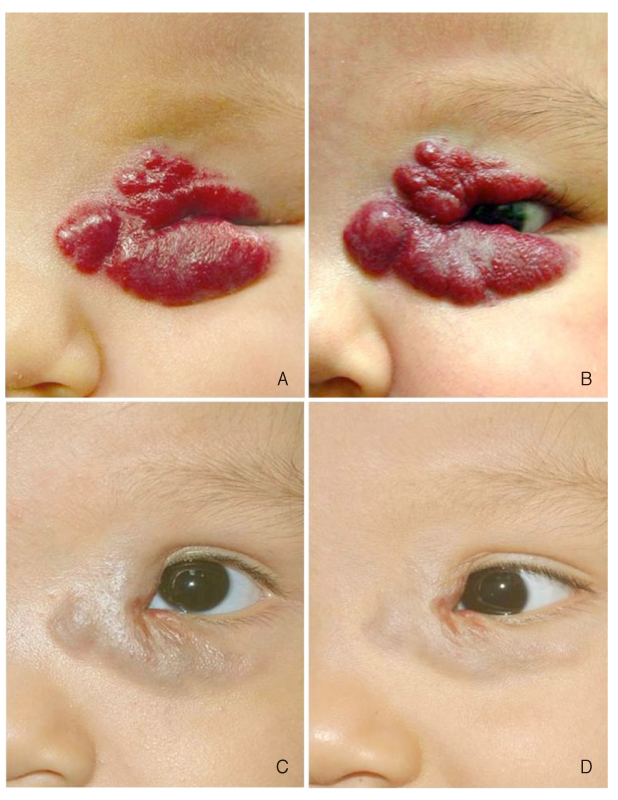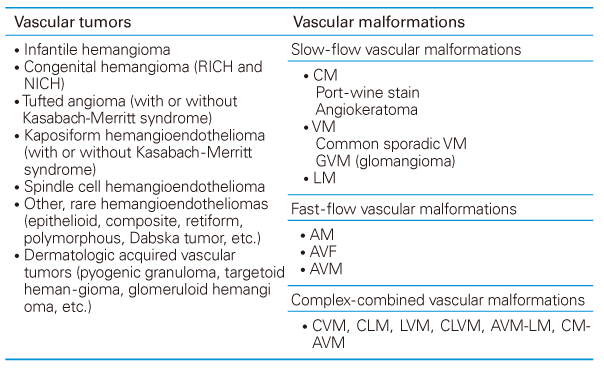 |
 |
- Search
| J Korean Med Assoc > Volume 54(8); 2011 > Article |
Abstract
Infantile hemangioma (IH), a common vascular tumor from vascular birth marks, used to be untreated due to its natural course of spontaneous regression with few exceptions like cosmetic disfigurement, functional or life impairment. It has been treated through a variety of methods like the topical and systemic corticosteroid, surgery, laser, etc. Among them, systemic corticosteroid, which has been used most commonly, may sometimes cause troublesome side effects such as temporary growth retardation or personality change, so it is often clinically inapplicable. Recently, however, it was reported that treatment using beta blocker for IH is more effective with fewer side effects than conventional treatments. Oral beta blocker has been used for IH patients who concerns about presenting ulcerative lesions, impending cosmetic sequelae or functional and life impairment. Before the administration of beta blocker, the patient goes through inquiry about clinical history, physical examination, electrocardiogram and echocardiography in order to determine the applicability. During the hospital stay, vital signs and blood glucose level are checked regularly to rule out side effects of beta blocker, and the dosage is increased gradually up to 2 mg/kg/day and the same dose is maintained continuously after discharge with same dosage. After considering many previous studies about beta blocker for IH patients, we reached an interim conclusion. The treatment of IH using beta blocker is effective, highly satisfactory and safe with no side effects though the selection from various beta blockers, evaluation methods of therapeutic efficacy and its duration and end point of treatment need to be confirmed.
Acknowledgement
I would like to express my sincere gratitude to Dr. Chang Hyun Song, Department of Dermatology, Kyung-pook National University School of Medicine for reviewing the manuscript.
References
1. Mulliken JB, Glowacki J. Hemangiomas and vascular malformations in infants and children: a classification based on endothelial characteristics. Plast Reconstr Surg 1982;69:412-422.
2. Enjolras O, Wassef M, Chapot R. Color atlas of vascular tumors and vascular malformations 2007;1st ed. New York: Cambridge University Press.
3. Chi SG, Jung HD, Lee SJ, Kim BS, Lee WJ, Kim DW, Chung HY, Yoon GS. Clinicopathological observation of hemangioma of infancy: the diagnostic usefulness of GLUT-1 immunohistochemical stain. Korean J Dermatol 2009;47:386-394.
4. Ahn HH, Kim YJ, Hwang ES, Kim IH. Clinical trial of 5% imiquimod cream for eleven cases of infantile hemangioma. Korean J Dermatol 2004;42:718-723.
5. Lee YS, Jung SW, Sim HS, Seo JK, Lee SK. Infantile hemangioma treated with dermal injection of ethanolamine oleate. Korean J Dermatol 2010;48:627-630.
6. Boon LM, MacDonald DM, Mulliken JB. Complications of systemic corticosteroid therapy for problematic hemangioma. Plast Reconstr Surg 1999;104:1616-1623.
7. Tsang MW, Garzon MC, Frieden IJ. How to measure a growing hemangioma and assess response to therapy. Pediatr Dermatol 2006;23:187-190.
8. DL Kellogg Jr. In: Wolff K, Goldsmith LA, Katz SI, Gilchrest BA, Paller AS, Leffell DJ, editor. Skin changes due to other physical and chemical factors. Fitzpatrick's dermatology in general medicine 2008;7th ed. New York: McGraw-Hill. 837-841.
9. Waner JS, Suen JY. In: Waner M, Suen JY, editor. The natural history of hemangiomas. Hemangiomas and vascular malformations of the head and neck 1999;New York: Wiley-Liss. 27-29.
10. Yang YJ, Min J, Choi YJ, Kim HJ, Lee G, Kim WS. Infantile hemangioma presenting as perianal ulcers. Korean J Dermatol 2011;49:28-31.
11. Chung HJ, Chung KY. Clinical and histopathological analysis of infantile hemangiomas. Korean J Dermatol 2004;42:1263-1270.
12. Frieden IJ, Eichenfield LF, Esterly NB, Geronemus R, Mallory SB. Guidelines of care for hemangiomas of infancy. American Academy of Dermatology Guidelines/Outcomes Committee. J Am Acad Dermatol 1997;37:631-637.
13. Chiller KG, Passaro D, Frieden IJ. Hemangiomas of infancy: clinical characteristics, morphologic subtypes, and their relationship to race, ethnicity, and sex. Arch Dermatol 2002;138:1567-1576.
14. Goldberg NS, Rosanova MA. Periorbital hemangiomas. Dermatol Clin 1992;10:653-661.
15. Bruckner AL, Frieden IJ. Hemangiomas of infancy. J Am Acad Dermatol 2003;48:477-493.
16. Hasan Q, Tan ST, Xu B, Davis PF. Effects of five commonly used glucocorticoids on haemangioma in vitro. Clin Exp Pharmacol Physiol 2003;30:140-144.
17. O'Keefe M, Lanigan B, Byrne SA. Capillary haemangioma of the eyelids and orbit: a clinical review of the safety and efficacy of intralesional steroid. Acta Ophthalmol Scand 2003;81:294-298.
18. Michaud AP, Bauman NM, Burke DK, Manaligod JM, Smith RJ. Spastic diplegia and other motor disturbances in infants receiving interferon-alpha. Laryngoscope 2004;114:1231-1236.
19. Moore J, Lee M, Garzon M, Soffer S, Kim E, Saouaf R, del Toro G, Yamashiro D, Kandel J. Effective therapy of a vascular tumor of infancy with vincristine. J Pediatr Surg 2001;36:1273-1276.
20. Léauté-Labrèze C, Dumas de la Roque E, Hubiche T, Boralevi F, Thambo JB, Taïeb A. Propranolol for severe hemangiomas of infancy. N Engl J Med 2008;358:2649-2651.
21. Denoyelle F, Leboulanger N, Enjolras O, Harris R, Roger G, Garabedian EN. Role of Propranolol in the therapeutic strategy of infantile laryngotracheal hemangioma. Int J Pediatr Otorhinolaryngol 2009;73:1168-1172.
22. Buckmiller L, Dyamenahalli U, Richter GT. Propranolol for airway hemangiomas: case report of novel treatment. Laryngoscope 2009;119:2051-2054.
23. Sans V, de la Roque ED, Berge J, Grenier N, Boralevi F, Mazereeuw-Hautier J, Lipsker D, Dupuis E, Ezzedine K, Ver-gnes P, Taïeb A, Léauté-Labrèze C. Propranolol for severe in-fantile hemangiomas: follow-up report. Pediatrics 2009;124:e423-e431.
24. Helfand M, Peterson K, Dana T. Drug class review on beta adrenergic blockers: final report [Internet] 2007;cited 2011 Jul 11. Portland (OR): Oregon Health & Science University. Available from: http://www.ncbi.nlm.nih.gov/books/NBK10440/
25. Nguyen J, Fay A. Pharmacologic therapy for periocular infantile hemangiomas: a review of the literature. Semin Ophthalmol 2009;24:178-184.
26. Léauté-Labrèze C, Taïeb A. Efficacy of beta-blockers in infantile capillary haemangiomas: the physiopathological significance and therapeutic consequences. Ann Dermatol Venereol 2008;135:860-862.
27. Annabi B, Lachambre MP, Plouffe K, Moumdjian R, Béliveau R. Propranolol adrenergic blockade inhibits human brain endothelial cells tubulogenesis and matrix metalloproteinase-9 secretion. Pharmacol Res 2009;60:438-445.
28. Shyu KG, Lu MJ, Chang H, Sun HY, Wang BW, Kuan P. Carvedilol modulates the expression of hypoxia-inducible factor-1alpha and vascular endothelial growth factor in a rat model of volume-overload heart failure. J Card Fail 2005;11:152-159.
29. Song CH, Jun JH, Chi SG, Lee SJ, Kim HY, Lee WJ, Kim DW. Seven cases of infantile hemangioma treated with beta blocker (Indenol®). Korean J Dermatol 2010;48:Suppl 1. 145.
30. Paik SH, Kim YG, Kim KH. Novel treatment of infantile hemangioma with propranolol: the first Asian case report. Korean J Dermatol 2010;48:Suppl 1. 286.
31. Khunger N, Pahwa M. Dramatic response to topical timolol lotion of a large hemifacial infantile haemangioma associated with PHACE syndrome. Br J Dermatol 2011;164:886-888.
32. Guo S, Ni N. Topical treatment for capillary hemangioma of the eyelid using beta-blocker solution. Arch Ophthalmol 2010;128:255-256.
33. Zimmermann AP, Wiegand S, Werner JA, Eivazi B. Propranolol therapy for infantile haemangiomas: review of the literature. Int J Pediatr Otorhinolaryngol 2010;74:338-342.
34. Breur JM, de Graaf M, Breugem CC, Pasmans SG. Hypoglycemia as a result of propranolol during treatment of infantile hemangioma: a case report. Pediatr Dermatol 2011;28:169-171.
35. Pavlakovic H, Kietz S, Lauerer P, Zutt M, Lakomek M. Hyperkalemia complicating propranolol treatment of an infantile hemangioma. Pediatrics 2010;126:e1589-e1593.
36. Abbott J, Parulekar M, Shahidullah H, Taibjee S, Moss C. Diarrhea associated with propranolol treatment for hemangioma of infancy (HOI). Pediatr Dermatol 2010;27:558.
Figure 1
Patient case: (A) pretreatment, (B) no improvement after 3 months of steroid treatment, (C) marked improvement after 2 months of propranolol (Indenol®) treatment and (D) continued improvement after 4 months of treatment. Informed consent was received from parents of the patient.

- TOOLS
-
METRICS

-
- 0 Crossref
- 2 Scopus
- 1,239 View
- 4 Download
-
Related articles in
J Korean Med Assoc -
Update on recent research into infantile hemangioma2016 September;59(9)






